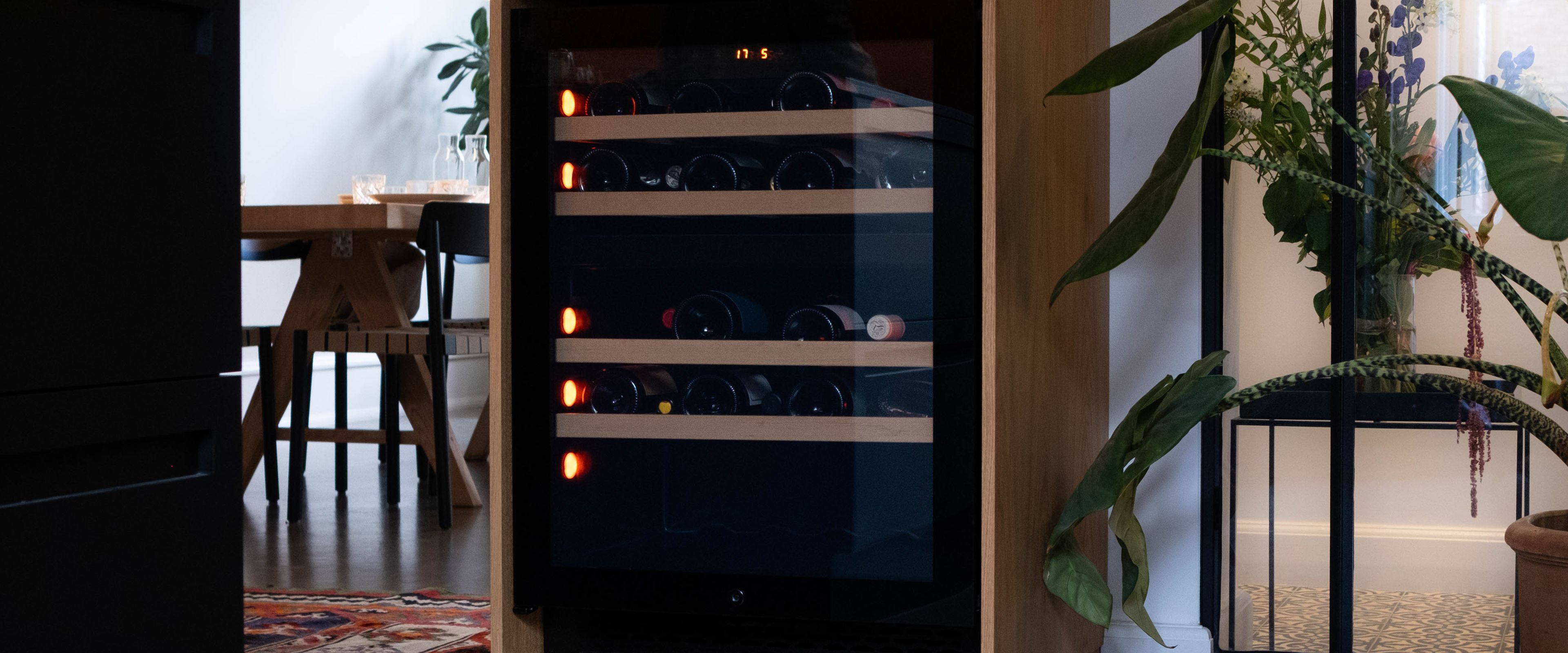
Guides
Built-in and integrated wine coolers
Are you thinking about buying a wine cooler but are unsure whether it should be an integrated or built-in wine fridge? Find out more here.
Bjarne, Sales & Interior design, Wineandbarrels

Free standing
Generally speaking, wine coolers are divided into three different types; freestanding, built-in and integrable. A freestanding wine cooler is simple enough and can be placed pretty much wherever you want as long as there is 5 cm of free air space on all sides.
But the confusion can arise with the other two types, as many people think of them as the same solution, i.e. as part of a cooking island, kitchen cabinet or similar. While it's true that the final results can be similar, there are still a few important differences.

Built-in
The main visual difference between built-in and integrated wine coolers is that the built-in ones have simpler dimensions. A built-in wine fridge will almost always have a standard width of 59.5 cm. This is because they are made to replace a kitchen module.
Most Danish kitchens come with high and low cabinets and have a width of 60 cm. This means that if you remove one of these cabinets, you can insert a built-in cabinet as a direct replacement.
One of the most common examples is if you imagine a space under your kitchen worktop, where you might also have a washing machine or dishwasher.
Here, the wine cooler will simply be pushed under the worktop, while the front will be visible and flush with the rest of the kitchen surfaces.
The depth of a built-in wine cooler will usually be max. 60 cm, which corresponds to most Danish kitchen modules, but there may of course be exceptions.


Integrated
With an integrated wine cooler, the wine cooler is placed inside an existing kitchen unit. This means that the kitchen unit is already in place, that being either high or low, and the wine cooler is then placed on top of a shelf inside the kitchen unit.
An integrated wine cooler is further characterised by the fact that the cabinet itself has smaller dimensions than the kitchen unit, as it needs to fit inside. For example, the width of the wine cooler will typically be 55.5 cm (and always under 60 cm), while its door will be slightly wider to cover the frame of the kitchen module.
This gives a more complete and finished look and fits into most modern kitchens


Air circulation is essential
Whether you are considering a built-in wine cooler or to be integrated into your kitchen, there is one parameter that must always be met, and it is correct air circulation. A correct ventilation solution is essential for the wine cooler to function optimally and last as long as possible.
The simplest solution of the two is the built-in one. The only requirement here is that there is free air passage at the bottom of the wine cooler’s front. Here, the wine cooler’s grate will ensure that new and fresh air can enter and that the warm air can be pushed out.
Some wine coolers have a so-called recessed base, which means that you can place your own base in front for a more complete result. The only requirement is that there is a grate in the base.
When it comes to the integrated wine coolers, a little more is required. There must be air behind the wine cooler as well as at the top and bottom. This is because the wine cooler draws in fresh air and blows out the warm air behind the wine cooler.
Since hot air rises upwards, it must be able to escape at the top through an opening in the cabinet cabinet. Similarly, the wine cooler must be able to draw in fresh air from below through a gap behind the shelf where it stands and through a grate in the same way as in a built-in wine cooler.
The free air behind the wine cooler ensures a constant and unhindered circulation of both warm and fresh air. If you are in doubt about the installation of an integrated wine cooler, we recommend that you contact one of our sales assistants for further guidance.
Only your imagination sets the limits
If the above requirements are met, it is almost only the imagination (and perhaps the budget and available space) that sets the limits. And fortunately, when it comes to budget and wine cooler size, there’s something for everyone.
So whether you’re looking for an integrated solution with just one temperature zone for 24 bottles of everyday wine or a built-in wine cooler with two zones for 150 bottles for both serving and long-term storage, we’ve got you covered.